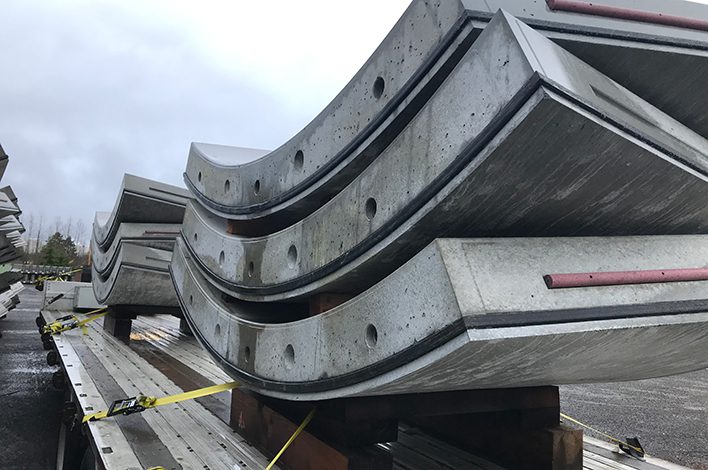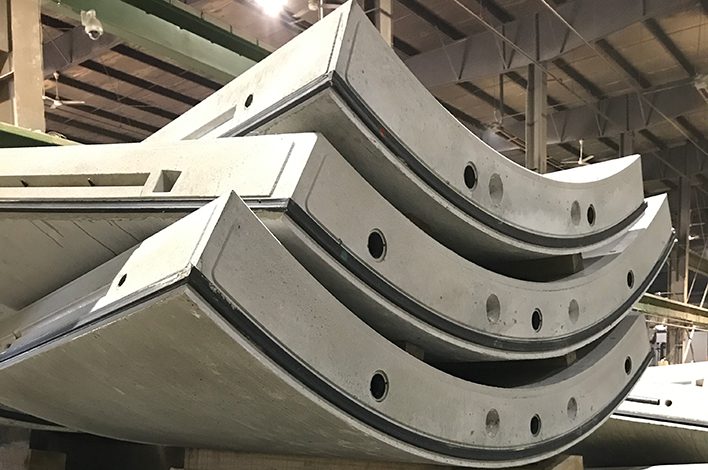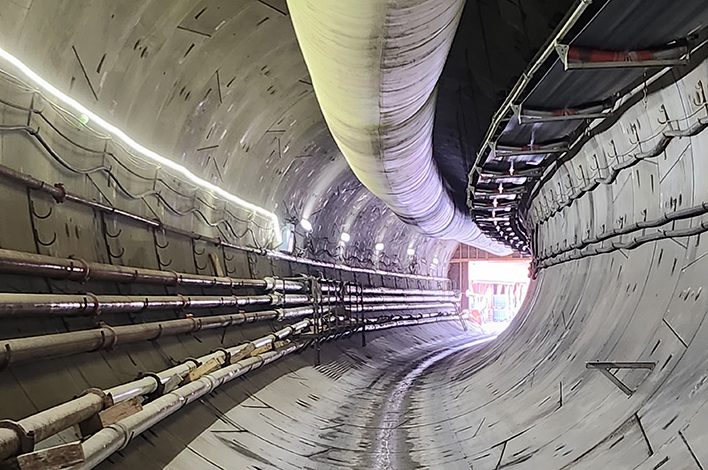Precast concrete features prominently in a project to reduce pollution in Lake Erie
Project Clean Lake, a $3 billion, 25-year undertaking by the Northeast Ohio Regional Sewer District (NEORSD) in Cleveland, aims to reduce raw sewage discharge in Lake Erie by 4 billion gallons per year. The plan calls for the installation of seven underground tunnels — ranging in length from 2 to 5 miles each. These tunnels, lined with precast concrete segments, will capture and store 98% of Cleveland’s sewer overflow so it can be treated at one of NEORSD’s three wastewater treatment plants. The plan also includes deep-tunnel pump stations and improvements to the treatment plants to handle increased capacity.
“We’re held to a much higher capture rate than other municipalities because our overflow goes to Lake Erie, and Lake Erie is the shallowest of the great lakes and the one that holds over half of the Great Lakes wildlife,” said Robert Auber, CCM, construction manager for NEORSD.
Planning began in 1995, with work on the tunnels starting in 2011. Euclid Creek, Dugway, Doan Valley and Westerly tunnels are completed and fully operational. Shoreline is currently under construction, and the Southerly and Big Creek tunnels should be completed within two-and-a-half years. Construction of these main tunnels constitutes 96% of the project.
“Tunnels are becoming more and more prevalent in the urban landscape with cities growing larger and the EPA emphasis on cleaning up the environment,” said Chris Lynagh, P.E., STSC, project manager for the Shoreline Tunnel for McNally Tunneling in Cleveland. McNally Tunneling also worked on the Euclid Creek and Doan Valley tunnels.
ON-THE-JOB LEARNING
Euclid Creek, the first single-pass tunnel NEORSD built, began the learning process.
“We made it through a lot of trial and error from Euclid Creek to Shoreline,” Auber said.
As the precast tunnel segments are placed, grout is injected through the segments to fill the voids left by overcut and the tunnel boring machine (TBM) skin thickness. Getting the grout mixture right was the most critical part of the job because, as Auber said, “the whole success and schedule of the job was based on it.”
The precast segments are grouted in place to withstand the pressure of the tunnel boring machine’s thrust. It was imperative that the grout set within 30 seconds. After more than 70 tries, they finally achieved success.
Guide rods, installed on the radial joints of the precast segments, were introduced to the tunnel requirements with the Doan Valley project. These guide rods allow the correct positioning and the longitudinal alignment of precast segments.
“That was not a common practice when the Euclid Creek tunnel was built,” said Reece Armitage, vice president and quality control & projects manager for CSI-Tunnel Systems, which fabricated the precast segments. “Now, guide rods are on almost every tunnel project.”
Another issue that had to be addressed was the handling and storing of the huge precast segments to avoid cracking.
“When the segments are in their final configuration underground, they’re in a circle,” Lynagh said. “A circle or cylinder behaves well in compression when the ground is squeezing against it. It’s what the segments are designed for. But when you are handling them on the surface – transporting them, lowering them to the shaft, getting them to the TBM – it’s critical to carefully calculate all those loadings to ensure you’re not overstressing the segments. Being diligent on the transportation process and the handling of the segments is a key thing we learned over all the projects, and it’s something we put a big emphasis on.”
With every project, the team learns something new.
“Shoreline is, so far, the best quality build with the segments we’ve had so far,” Auber said.

BUSINESS AS USUAL
To date, CSI-Tunnel Systems’ Macedonia, Ohio, plant has fabricated the precast segments for the first five Project Clean Lake tunnels.
“We do only one thing — make concrete segmental liners for tunnels,” Armitage said. “And we’ve been doing it for 28 years.”
CSI educated NEORSD about the characteristics of fiber reinforced concrete compared to steel rebar, and the agency opted to try it out.
“We did fiber distribution tests where we broke the segments to see how the fibers were distributed within each panel,” Auber said. “We had the distribution we needed, the tensile strength, the flexural strength – plus, it mitigated corrosion. The steel fibers are discontinuous so they don’t corrode like rebar would.”
CSI used a 675-pound cementitious content mix, including silica fume, to achieve an extremely high-performance, low-permeability concrete. The mix is poured into Cleco molds, finished at a workstation, placed into a kiln for five hours and then transported to the yard to cure. It’s an assembly line of which Henry Ford would be proud.
“During the day, we pour one element every five minutes,” Armitage said. “This is what we do. All these projects went quite smoothly.”
Durable precast concrete has a lifespan of 100-plus years, which was one reason it was selected as the building material.
“Precast is becoming the norm for these kinds of tunnels,” Armitage said, adding that it does depend on the ground conditions.
Each tunnel ring is composed of six segments. For the Euclid Creek project, CSI fabricated 18,900 segments (3,150 rings). Each ring weighs 26 tons. The dimensions of the segments are 24 feet inside diameter by 12 inches thick by 5 feet long. The heaviest weighs 11,700 pounds, while the lightest weighs 6,300 pounds.
The Shoreline project consisted of 14,004 segments (2,334 rings), with each ring weighing 67,700 pounds. The segments measure 23 feet inside diameter by 12 inches thick by 6 feet long. The heaviest weighs 12,977 pounds and the lightest 4,166 pounds.
HITTING THE ROAD
Flatbed trucks transported the segments from Macedonia to the Cleveland job site — about a 40-minute drive. Besides containing costs, keeping the project eco-friendly is a major concern. The Shoreline project is “green,” with a 17% reduction in carbon emissions. Proximity to the job site factors into that accomplishment.
Great care was taken in loading the segments, with timber cribbing placed strategically to reduce stress on the segments. For the first four tunnel projects, CSI loaded six segments on one truckload.
“But the Shoreline segments are 6 feet in length, so we had to be creative,” Armitage said. “We put four pieces of a ring on one truck, three times. Then we loaded the fourth truck with six smaller pieces.”
“During transportation is where a lot of the micro-cracks can occur,” Lynagh said. “When you get underground and start thrusting off them with the TBM is when the microcracks open up.”

PUTTING IT ALL TOGETHER
Once the precast segments arrive at the job site, a segment clamp places them on the ground until they are lowered into the shaft. Then a Multiphysics vehicle transports them to the heading of the TBM where hydraulic machines unload them. Finally, a segment crane sets the segments on a tray that feeds them to the tail shield of the TBM.
Most tunnel work takes place 150 feet underground. Safety is a major concern.
“There are a lot of issues with shale,” Auber said. “There can be fallout between the bedding planes or the crown area. Plus, shale contains methane gas. A single-pass tunnel allows you to mitigate any gas issues and allows you to prevent any fallout associated with shale.”
The basic installation steps are similar for tunnels bored from Chagrin shale (Euclid Creek, Dugway, Doan Valley, Westerly, Big Creek) and soft soil (Shoreline, Southerly). The TBM installs the six precast segments that make a ring. The segments are anchored together, then grouted in place. Then the TBM moves forward, thrusting off the newly installed ring, and installs another set of rings. Workers are never in front of the machine. They are always working in a finished tunnel, which makes it safer.
There are differences in the installation of the segments in shale and soft soil, though. Tunnels built in shale have cast-in-place starter tunnels. These tunnels, up to 350 feet in length, are large enough for the TBM to be lowered underground in pieces, where it is assembled.
For Shoreline, the first soft ground tunnel, a 26-foot earth pressure balance TBM, designed especially for 6-foot segments, was used to stabilize the tunnel and equalize the pressures from the excavation in front of the machine. Embedded neoprene gaskets are used around the entire circumference of the segments to seal each segment to the adjacent one to help the tunnels withhold the higher ground pressure, and foam strips were added to ensure the grout didn’t leak into the TBM’s tail shield. Since the segments were so heavy, extra care had to be taken with the handling process.
Installation on Shoreline was quick.
“We installed 126 feet in a single 24-hour day,” Lynagh said. “That’s our best day to date on the Shoreline tunnel project.”
FORWARD LOOKING
Project Clean Lake presented many firsts for the NEORSD, which isn’t afraid of change.
“Life is dynamic, and you have to follow that path,” Auber said. “Nothing good happens when you’re reactionary. Other agencies around the country come to us to see how it’s done — the grout mix, using plastic fibers in the cast-in-place, using steel fibers in the precast segments. These are all firsts (for us). It’s a win-win for the community.”
